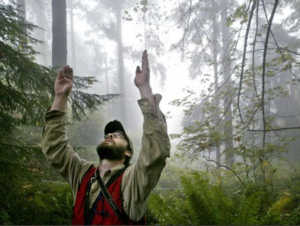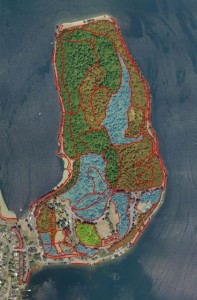
Nelson Salisbury, ecologist with EarthCorps Science, conducted the baseline assessment of Seattle’s public lands.
Ever wonder how GSP prioritizes work, classifies forest health and measures success?
This summer, we categorized 54 acres as “Phase IV” in Seward Park alone. This means those restoration zones meet much of our criteria for a healthy forest. It doesn’t mean we are done; some of these areas will receive a little attention this year, and then go into a cycle of long term stewardship and maintenance.
The Seattle Urban Nature Project mapped our conifer, madrone and oak forests during the 1999-2000 Seattle Public Lands Habitat Survey. In recent years, we started regularly visiting a number of zones in active restoration, and creating estimates along a number of ecological dimensions based on an inventory protocol developed by staff and partners. A result of the inventory is the ability to classify zones based on ecological qualities. A classification system, called “Tree-iage”, is used to prioritize work and predict costs. It has been updated in recent years to include more detailed measurements. Voila: Tree-iage 3.0!
 The Target Ecosystem in a park or zone describes the reference habitat that we intend to replicate. Each target ecosystem corresponds to an ecosystem identified by the Washington State Department of Natural Resources Natural Heritage Program. Nested within the target ecosystem classification are Target Forest Types, native plant associations that provide a more specific planting palate to guide restoration.
The Target Ecosystem in a park or zone describes the reference habitat that we intend to replicate. Each target ecosystem corresponds to an ecosystem identified by the Washington State Department of Natural Resources Natural Heritage Program. Nested within the target ecosystem classification are Target Forest Types, native plant associations that provide a more specific planting palate to guide restoration.
For each zone, the data collected in the inventory is measured against the target thresholds to determine whether or not the zone can be considered Phase IV. We like to see a nice canopy of conifers, madrones or oaks + a diversity of new native trees and understory plants + almost zero weed coverage + low numbers of weed trees regrowing. Is that too much to ask? The Phase IV zones are shown in dark green on the GSP Reference Map http://arcg.is/1AiOSUB.
Forests in Seward Park looked relatively good at the start of the GSP. Generous funding to Seattle Parks from a private donor via the The Seattle Foundation has sustained our efforts to keep it looking magnificent. Additional help from Seward Park Audubon Center, Earthcorps, Forterra and countless others has gone into removing invasive weed species and underplanting these forests with native seedlings to succeed as the next generation of forest.
Want to meet others interested in keeping Seward Park looking awesome? If so, peruse the GSP event calendar or contact Seattle Parks and Recreation Plant Ecologist, Lisa Ciecko at lisa.ciecko@seattle.gov.


